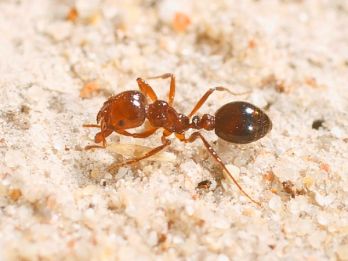Red imported fire ant
The red imported fire ant (Solenopsis invicta) is aggressive, representing a serious risk to our health, environment and economy.
Red imported fire ants (RIFA) are a notifiable pest in South Australia, which means there is a legal obligation for everyone to report suspected detections.
Early reporting, by members of the community and industry, is a vital part of preventing them from establishing and spreading.
Background
Fire ants, native to South America, spread naturally through mating flights and budding. A mated female (queen) can fly up to 2 kilometres, while a newly mated queen finds a suitable nesting site, sheds her wings and starts a new colony.
The first detection in Australia occurred in 2001 in Brisbane, which continues to be the target of a national cost-shared eradication program.
Moving host material such as containerised plants, potting media, soil, organic mulch, turf, hay, straw, agriculture machinery or used containers from Queensland into South Australia is prohibited, unless certified.
Impacts
Fire ants will affect everyone, with the potential to:
- limit Australia's outdoor lifestyle
- devastate our environment, damaging native flora and fauna
- reduce production of agricultural industries, such as orchards, crops and pastures
- damage equipment and infrastructure
- lower land and business values.
They may even jeopardise our naturally clean and green export image.
If fire ants bite children and pets they cause serious distress, inflicting a painful, burning sting.
Identification
The RIFA is similar to several local ant species. They are 2 to 6 mm long, and reddish-brown with a dark brown rear segment.
These ants are aggressive and agitated when disturbed. They will repeatedly sting anything that appears a threat.
Habitat
Red imported fire ant nests vary in shapes and sizes depending on age and soil type. They are usually closed (no central opening), formed in a dome shaped mound up to 45 cm high.
Fire ants can invade backyards, parks and recreational areas. Humans can spread fire ants via:
- shipments of infested nursery stock, soil or other carriers
- materials and containers stored in fire ant biosecurity zones
- machinery that has been used to move soil.


